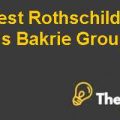
Abbott Laboratories
Introduction
The report presents a financial analysis of Abbott Laboratories for the year ended 2008, 2010 and 2012 in order to evaluate the financial performance of the company. Further, the report also presents a comparison with Merck Pharmaceuticals in order to facilitate better comparison.
Return on Capital Employed (ROCE):
Return on capital employed is a measure of profitability and efficiency, which measures how efficiently a company generates return from its capital employed.
ROCE of Merck for the year 2008 represents 8.53% whereas Abbott reported better results of 18.47%, which indicates that Abbott had generated sufficient returns over its capital employed that would boost investors’ confidence over the company.
ROCE of Abbott and Merck had been reduced for the last two years from 18.47% to 14.06% and 8.53% to 5.85% respectively in 2010, which indicates that the company failed to generate sufficient returns from its capital employed. This might be because both the company’s had heavy investment in total assets which increased the base of the indicator and both the company’s faced a decrease in ROCE. Further, Abbott had also reported a reduced operating profit margin as compared to the last two years which results for a company to report reduced ROCE. Additionally, ROCE of 14.06% of Abbott is far better than Merck’s results of 5.85%, which indicates that Abbott had efficiently utilized its assets in order to generate profits as compared to Merck.
Further, the ROCE of Merck for the year 2012 represents 5.64% whereas for Abbott it represents 14.98%. Abbott had reported far better results than previous two years whereas Merck didn’t show better results as compare to last two years. Abbott reported better results because it invested in assets which benefited them to generate sufficient operating profits whereas Merck didn’t succeed to effectively utilize its assets and reported a reduction in operating profit which ultimately made them to report a reduced return on capital employed.
Asset Turnover:
Asset turnover ratio measures efficiency which determines how well a company utilizes its assets in order to generate revenue.
The asset turnover of Abbott for the period 2008 represents 0.72 times that was substantially higher than the asset turnover of Merck; which represented only 0.49 times and also indicated that Abbott had efficiently utilized its assets in order to generate sufficient sales.
The turnover ratio of Abbott had has decreased over the last two years from 0.72 times to 0.62 times in 2010. Although, the sale of Abbott had increased from the last two years but the company had heavily invested in assets, which made them to report a reduction in asset turnover. Whereas, the reported asset turnover was substantially higher than Merck results of 0.48 times which indicates that Abbott had effectively utilized its assets.
Further, Abbott had reported slight increase in its asset turnover for last two years from 0.62 times to 0.63 times in 2012. Further, the asset turnover of Merck has also been increased for the last two years from 0.48 times to 0.51 times but the resulting ratio was still lower than the results of Abbott. This might be because both the companies reported an increase in sales and this might be possible that the assets had been depreciated.
Operating Profit Margin:
Operating profit margin is a profitability indicator which measures how efficiently a company has controlled its costs in order to generate sufficient profit.
The operating profit margin of Merck for the year 2008 was 14.97% that was slightly lower than the profit margin of Abbott which represented 19.28%; which indicates that Abbott had controlled its cost efficiently in order to generate sufficient operating profit margin.
The operating profit margin of Abbott and Merck for the year 2010 has decreased over the last two years from 19.28% to 17.31% and 14.97% to 11.99% respectively.This was a bad indicator that both the companies failed to control their costs; which resulted as a decrease in operating profit margin. Although, the results of Abbott had reduced than last year but the reported results were far better than Merck’s results.
Abbott succeeded to increase its operating profit margin in 2012 which had increased from 17.31% to 20.28%. This is a good indicator that the company succeeded to reduce its cost whereas, Merck has presented some bad results over the last two years from 11.99% to 8.62% which represented that Merck would be required to take initial steps in order to control its cost substantially so that sufficient profits can be generated for distribution to its shareholders.
Gross Profit Margin:
Gross profit margin is a profitability indicator which measures how much a company retains after incurring the direct cost associated with producing the goods.
The gross profit margin of Merck for the year 2008 represented 74.78% whereas, for Abbott it represented 57.29%; this indicates that Abbott failed to control its cost of goods sold or this could also be a possibility that Abbott held gross profit at a lower level in order to increase its sales............................
This is just a sample partial case solution. Please place the order on the website to order your own originally done case solution.













